

|
Archive
Blog
Cast
Forum
RSS
Books!
Poll Results
About
Search
Fan Art
Podcast
More Stuff
Random
Support on Patreon |
|
New comics Mon-Fri; reruns Sat-Sun
|
1 {photo of the Great Pyramids of Giza}
1 Caption: Pyramids
|
First (1) | Previous (3368) | Next (3370) || Latest Rerun (2581) |
Latest New (5175) First 5 | Previous 5 | Next 5 | Latest 5 Annotations theme: First | Previous | Next | Latest || First 5 | Previous 5 | Next 5 | Latest 5 This strip's permanent URL: http://www.irregularwebcomic.net/3369.html
Annotations off: turn on
Annotations on: turn off
|
Pyramids seem to be endlessly fascinating. The very word "pyramid" conjures up a host of images, many associated with exotic places, ancient civilisations, esoteric and arcane powers, and other cool stuff. Possibly no other simple three dimensional geometrical shape carries with it quite so much imagery and fascinating mental associations.
Geometrically speaking, a pyramid is a three dimensional solid formed by taking a polygon as a base, then joining each corner of the polygon to a single point not in the plane of the polygon, to form one edge for each corner, and a triangular face for each edge of the polygon. Most pyramids we think of have a square base, but the base can also be triangular, rectangular, pentagonal, or any other shape. In the infinite limit of a polygon, the base can be smoothly rounded, like a circle or an ellipse, though a pyramid with a circular base is more usually called a cone.
The point, or apex, of a pyramid doesn't need to be centred above the base either, it can be skewed off to one side. If you built such a pyramid it would look like it's leaning over. And indeed it's hard to think about pyramids for long without thinking of them as buildings. Because the most famous pyramids are just that.
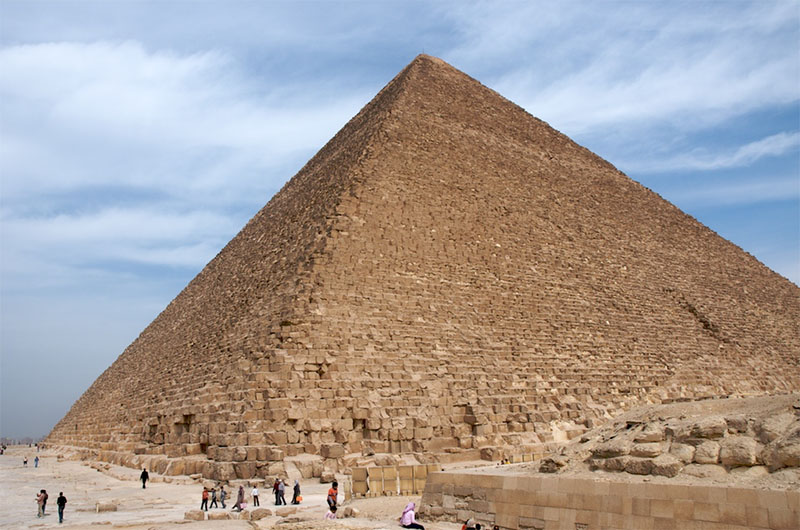 Pyramid of Khufu. Creative Commons Attribution-NonCommercial-Share Alike image, by Jason Quinlan. |
Perhaps the most famous of all are the pyramids of Ancient Egypt, with the Pyramids of Giza standing out among them. The Pyramid of Khufu (or Cheops, as the name was rendered in Greek) is the only one of the original Seven Wonders of the World which you can still see today and was, for 3,800 years, the tallest human-built structure in the world.[1] In its prime, the Great Pyramid was clad in a smooth surface of polished limestone, making its shape very close to perfectly pyramidal. The limestone has long since been scavenged for use elsewhere, leaving the core of sandstone to stand against the desert elements, which have worn it down over the centuries, leaving the top blunted.
The adjacent Pyramid of Khafre was almost as tall, and it retains some of the smooth cladding near the top, making it pointier today. The third pyramid in the trio is the smaller Pyramid of Menkaure. Next to Menkaure's pyramid is a cluster of three tiny pyramids, the queens' pyramids. The whole complex sits on a shallow sandstone plateau overlooking modern day Cairo. In fact these days suburban housing encroaches to within walking distance of the Pyramids. Part of the complex is the Great Sphinx of Giza, the famous statue of the human-headed lion which sits on guard, facing east away from the pyramids, looking over Giza and Cairo beyond.
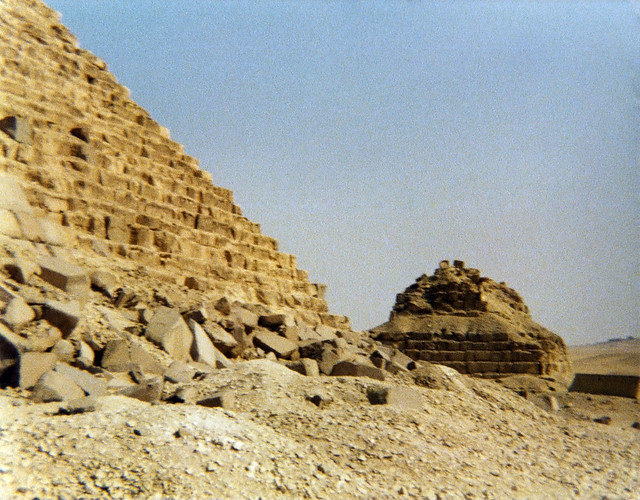 Pyramid of Menkaure and one of the Queens' Pyramids. |
The Great Pyramids date from around 2500 BC, some four and a half thousand years ago. The Pyramid of Khufu was already ancient when the other six Wonders of the World were being built, and it has outlasted them all. The famous queen of Ancient Egypt, Cleopatra, was a contemporary of Julius Caesar - to her, the Pyramid of Khufu was more ancient and removed in time (two and a half thousand years) than Cleopatra herself is from us (barely over 2000 years).
Egyptian pyramids were designed and built as tombs and memorials of the pharaohs, the rulers of Ancient Egypt. They have their architectural origins in earlier royal tombs known as mastabas. A mastaba is a low, square structure made of stone, with a flat top. The walls often slanted inwards, which helps provide stability. Cavities inside or underneath the mastaba would be used as the resting place for the departed pharaoh, or whoever else wanted a grand burial.
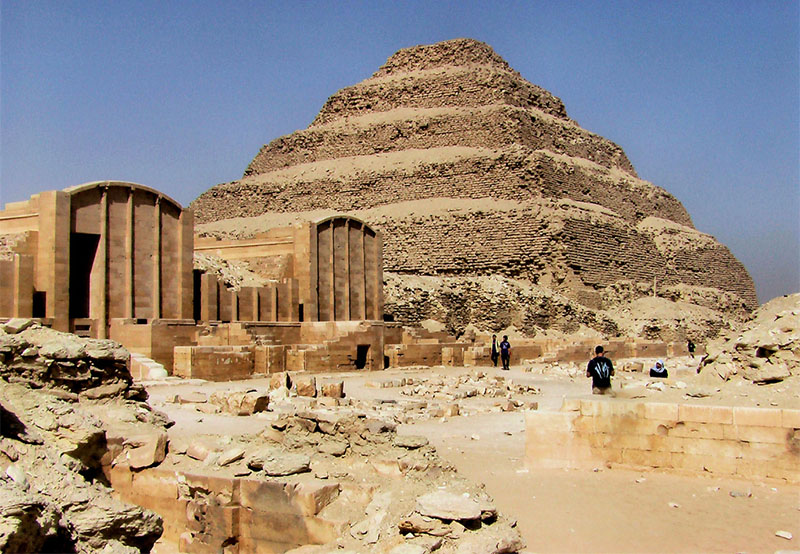 Step Pyramid of Djoser. Creative Commons Attribution-NonCommercial-Share Alike image, by Flickr user kairoinfo4u. |
The pharaoh Djoser (around 2670 BC) decided to go one better, and had builders stack a few mastabas on top of one another. This produced what is now known as the Step Pyramid of Djoser. It looks like a pyramid, but with a series of large, chunky steps cut into it. From here, the ancient architects got the idea of making the steps smaller while keeping the overall pyramidal shape, and then filling in the gaps with shaped stone to make a flat outer surface. And so the pyramid as a monumental structure was born.
All this happened before the reign of Khufu, who decided to one-up everyone who had gone before by ordering the largest pyramid ever built. Thousands of workers toiled for years to cut and move the huge stone blocks which make up the structure. It is mind boggling how much time and effort this would have required, so much so that many people over more modern centuries have questioned whether the task was humanly possible at all with the technology of the time. Calculations and simulations show it was certainly possible, but that hasn't stopped some from proposing that the Ancient Egyptians must have had some sort of assistance, either magical or extraterrestrial.[2]
The Great Pyramids are all aligned with the edges of their bases pointing north-south and east-west with high enough precision to imply very strongly that this was deliberate. This would have been easy enough to arrange with some sticks and rope and simple observations of the night sky. Clearly the rotation and alignment of the Earth were important symbolically to the Ancient Egyptians, and this is easy enough to understand when you realise how much a basic knowledge of astronomy helps an agricultural society.
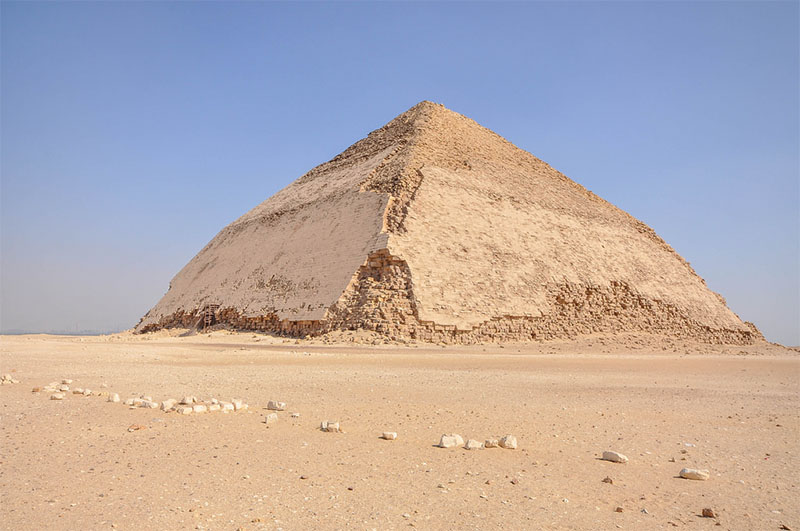 Bent Pyramid of Sneferu. Creative Commons Attribution image, by Jorge Láscar. |
Besides the famous Great Pyramids, there are dozens of other lesser known pyramids scattered across the Egyptian countryside. Some are still recognisably pyramids, but many are ruined to the point where the pyramidal shape is no longer obvious. Nevertheless, they were used as monuments and mausoleums for royalty. It would be an interesting fact if Egyptian pyramids were all built with precisely the same geometrical proportions, implying some sort of mystical/mathematical meaning, but this is not true. The sides of Egyptian pyramids slope at different angles, dictated perhaps by nothing more than the architects' whims. Even the pyramids of Giza are all differently proportioned. A pyramid built during the reign of the pharaoh Sneferu (around 2600 BC) was begun with quite steep sides, but the builders switched to a shallower slope halfway through. Archaeologists think the original slope may have proved too unstable, prompting the switch mid-construction, and resulting in the distinctive Bent Pyramid.
One problem, however, with building a pyramid as your tomb is that it's pretty obvious where you, and your funerary treasures, are buried. This made pyramids a prime target for tomb robbers, and indeed very few have turned up any substantial treasures worth speaking of in modern times. So as the centuries and then millennia passed (the Ancient Egyptian civilisation lasted a really long time), they stopped building pyramids as tombs and instead buried their pharaohs in hidden, unmarked locations. These tombs contained treasures because, unlike the modern dictum, the Ancient Egyptians believed you really could take it all with you.
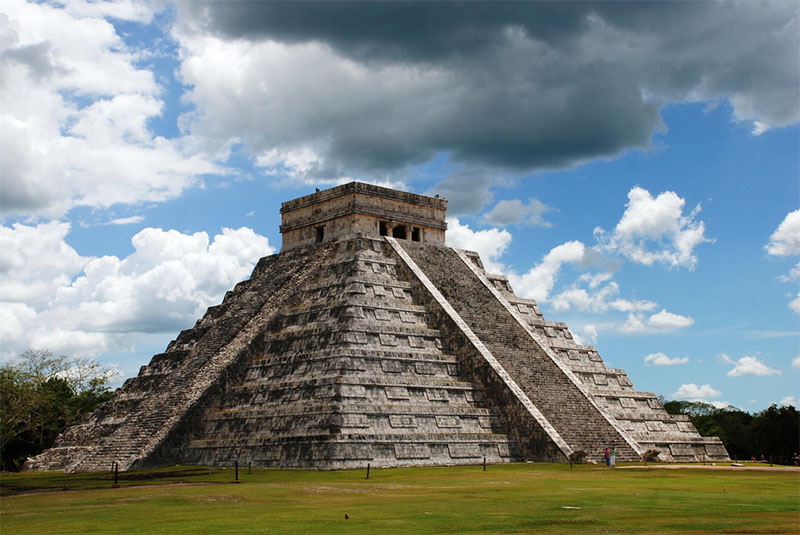 Pyramid of Kukulcan, Yucatan, Mexico. Creative Commons Attribution-NonCommercial-Share Alike image, by Jenny Pansing. |
So pyramid building petered out in Egypt. But other civilisations took up the fascination with pyramidal construction, and so we find pyramids elsewhere. The Mayan and Aztec civilisations of Central America built pyramids not as tombs, but as ceremonial centres. These pyramids had steps leading up one of the sides to a small temple located at the top of the structure. One some of these pyramids sacrificial victims were slain to appease bloodthirsty gods, and the bodies cast down the stairs. Again, many of these pyramids were aligned to Earth's axis of rotation, and for similar reasons, but that about does it for any similarity with Egyptian pyramids. Mesoamerican pyramids were architecturally and functionally very different.
Egyptian and Mesoamerican pyramids are the best known pyramidal structures of the ancient world, but many other cultures throughout history have also been fascinated by the shape and built pyramidal structures. These include early civilisations in Africa, Europe, south Asia, east Asia, South America, and North America - every continent except Australia and Antarctica!
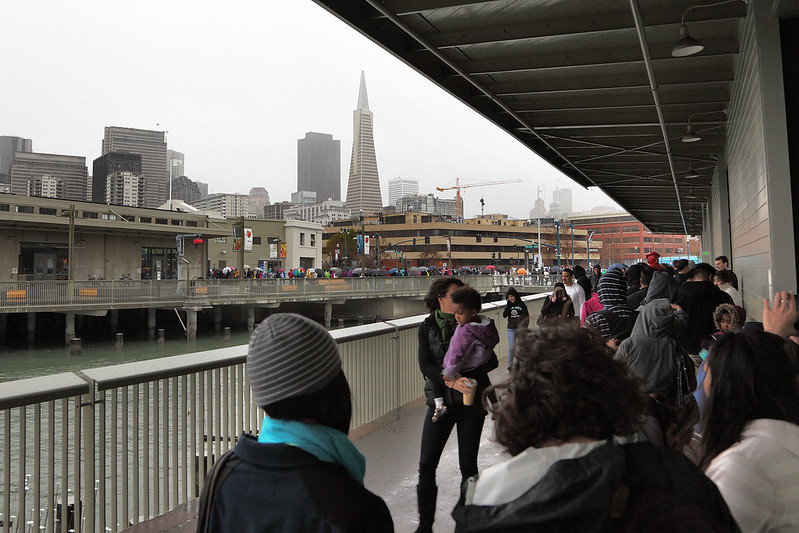 Transamerica Pyramid (centre), San Francisco. |
We have not stopped building pyramid shaped structures either. San Francisco has a tall, skinny pyramid in its distinctive Transamerica building. Las Vegas has a modern pyramid deliberately designed to to evoke Ancient Egypt. The new main entrance to the Louvre museum in Paris is a glass pyramid, strikingly counterpointing the baroque elegance of the palace around it. There's even a pyramid not far from where I live - the Tropical Centre glasshouse in Sydney's Royal Botanic Gardens.
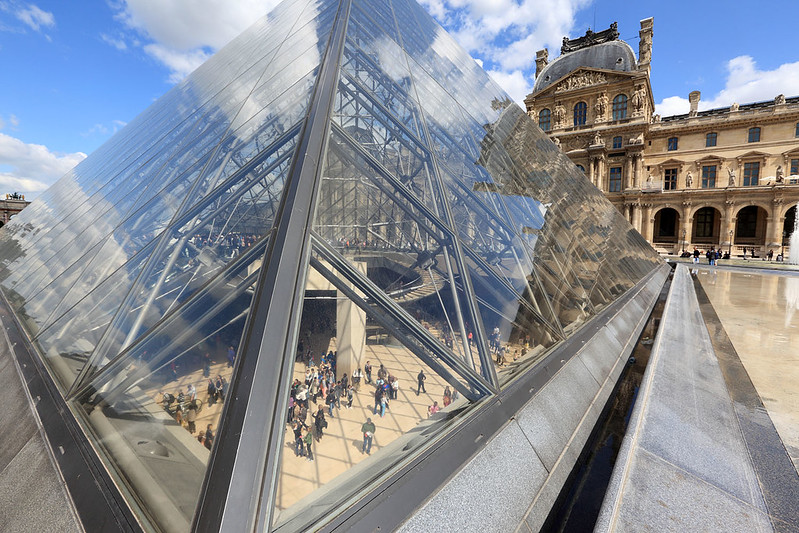 Louvre Pyramid, Paris. |
Pyramids attract us because their shapes are distinctive and unusual. They are the simplest geometrical shape we can comfortably make into a building, other than rectangular prisms and cylinders. Their very pointiness is aesthetically attractive for some reason. And so they inspire and fascinate us, and will continue to do so, hopefully for the next few thousand years and more.
[1] The Pyramid of Khufu was dethroned as the tallest structure in the world only in 1311, with the completion of Lincoln Cathedral in England - another manifestation of humanity's desire to believe in a life after death.
[2] This type of false logic, often invoked to conclude that magic or aliens are involved in all sorts of things based on the arguer not having the imagination to think that humans could have done something on their own initiative, is called argument from ignorance, or argument from incredulity.
|
LEGO® is a registered trademark of the LEGO Group of companies,
which does not sponsor, authorise, or endorse this site. This material is presented in accordance with the LEGO® Fair Play Guidelines. |